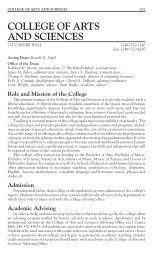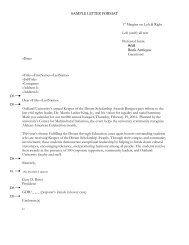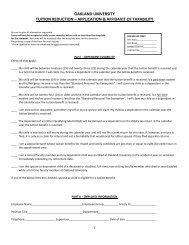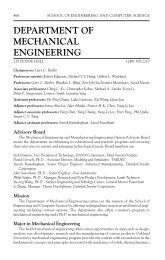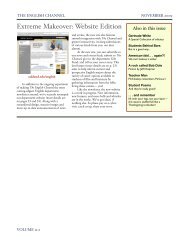MOM 2006 journal for pdf.pmd - University of Michigan-Flint
MOM 2006 journal for pdf.pmd - University of Michigan-Flint
MOM 2006 journal for pdf.pmd - University of Michigan-Flint
You also want an ePaper? Increase the reach of your titles
YUMPU automatically turns print PDFs into web optimized ePapers that Google loves.
Results<br />
Figure 2 shows phase plane plots (Φ m<br />
versus ∂Φ m<br />
/∂t) <strong>of</strong> the action potential at the locations<br />
marked “a”, “b”, and “c” in Fig. 1. The maximum rate <strong>of</strong> change is different between the upper<br />
(“c”, 287 V/s) and lower (“a”, 267 V/s) edges. The time constant <strong>of</strong> the foot <strong>of</strong> the action<br />
potential, τ foot<br />
, can be found by fitting the initial rise (from -79 to -69 mV) <strong>of</strong> the action potential<br />
to an exponential. In a phase plane plot, an exponential increase appears as a straight line. The<br />
foot <strong>of</strong> the action potential along the upper edge (“c”, 0.22 ms) is smaller than the time constant<br />
along the lower edge (“a”, 0.29 ms).<br />
The results depend on the conductivities <strong>of</strong> the cardiac tissue. When the conductivities were<br />
adjusted so the tissue had equal anisotropy ratios (σ iL<br />
=0.2, σ eL<br />
=0.2, σ iT<br />
=0.032, and σ eT<br />
=0.032<br />
S/m), the differences between the two edges disappeared. The results also depend on the angle<br />
that the fibers make with the boundary. Angles from 0 to 90° were simulated, with 75° showing<br />
the most significant effect. Finally, the behavior is different between the upper and lower edges.<br />
When a vector pointing from the sealed boundary into the tissue along the fibers makes an obtuse<br />
angle with the direction <strong>of</strong> propagation (like on the top edge), the rate <strong>of</strong> rise <strong>of</strong> the action<br />
potential is faster, and the time constant <strong>of</strong> the action potential foot is smaller, than when such a<br />
vector makes an acute angle with the direction <strong>of</strong> propagation (like on the bottom edge).<br />
Discussion<br />
The rate <strong>of</strong> rise <strong>of</strong> the action potential, and the time constant <strong>of</strong> the action potential foot, are<br />
sensitive to boundary effects. Previous studies (Roth, 1991; Roth, 2000) have shown that a<br />
conducting bath perfusing the tissue surface can affect the action potential upstroke. This study<br />
finds similar results <strong>for</strong> a sealed boundary with fibers approaching the surface at an angle. The<br />
effect disappears when equal anisotropy ratios are present or when the fibers are parallel or<br />
perpendicular to the surface. The changes in the action potential are not large, but may be<br />
detectable in experiments using a “wedge preparation”, in which the heart wall has been cut and<br />
the transmembrane potential is recorded on the cut surface (Akar and Rosenbaum, 2003; Fast et<br />
al., 2002).<br />
Acknowledgements<br />
This research was supported by the National Institutes <strong>of</strong> Health (R01 HL57207) and the<br />
SMaRT program an RED site at Oakland <strong>University</strong> funded by the National Science Foundation<br />
under Grant No. DMR-0552779. We thank Andrew King <strong>for</strong> his comments and suggestions.<br />
Meeting <strong>of</strong> Minds <strong>2006</strong> 66



